Bumble Bee Basics
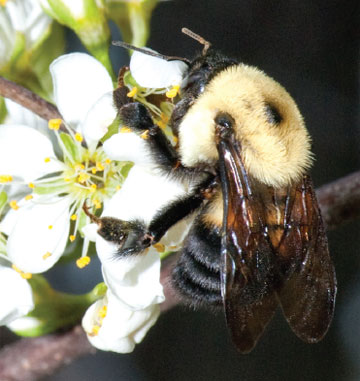 Bumble Bees in the Landscape
Bumble Bees in the Landscape
Bumble bees are among the most beloved and familiar garden insects. In our modern world of urbanization and more chemical-based, intensive agriculture, our bumble bees find themselves often hungry and homeless. This booklet campaign mirrors efforts throughout the world to learn more about these insects, their contributions to our lives, and how we can help them.
Fossil records indicate that bumble bees have been around for millions of years. However, several species of bumble bees are in decline and some species are in danger of disappearing. No single reason for their decline exists; a combination of factors including fewer flowering plants in the landscape, pathogens, and climate change are likely the cause. As gardeners or landowners, we can help bumble bees by providing them with a diversity of flowering plants.
Bumble Bee Behavior
Bumble bee behavior is fascinating. Did you know that bumble bees have smelly feet? Well they do and it is quite useful. After feeding they leave a scent on the flower which helps other bumble bees to avoid wasting energy landing on the flower – the visited flower will now contain little nectar or pollen.
Bumble bees are unique in the insect world and are very different from their cousins the honey bees and distant relatives such as wasps. Bumble bees are larger and hairier than honey bees which make them more suitable for colder climates. Bumble bee nests are smaller than honey bee nests; bumble bees do not store large quantities of nectar which makes them more sensitive to 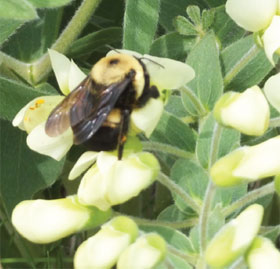 availability of pollen and nectar rich plants to feed on. These bees are not aggressive and rarely sting. The bumble bee’s strength, agility and unique attributes provide us with many food crops and colorful flowers in our landscapes.
availability of pollen and nectar rich plants to feed on. These bees are not aggressive and rarely sting. The bumble bee’s strength, agility and unique attributes provide us with many food crops and colorful flowers in our landscapes.
Regeneration and Resilience
The vitality of our bumble bees can be a force multiplier to strengthen our plant communities. Through the elegant process of cross pollination, bees can dramatically promote the regeneration and resilience of our natural landscapes, and the productivity of our fruit and vegetable crops. Bumble bees are well suited for pollination. They are strong, agile, and capable of working in highly varied temperature conditions.
The Elegance of Pollination
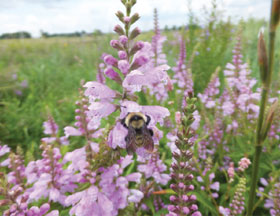 Globally, bees are the most important pollinators. The bounty of our harvest – most edible (and blooming) plants, vegetables, and fruits depends on fertilization. Fertilization occurs when pollen is transferred from the anther (male part) of one flowering plant to the stigma (female part) of plant of a different genetic origin.
Globally, bees are the most important pollinators. The bounty of our harvest – most edible (and blooming) plants, vegetables, and fruits depends on fertilization. Fertilization occurs when pollen is transferred from the anther (male part) of one flowering plant to the stigma (female part) of plant of a different genetic origin.
Bumble bees transfer pollen while they are gathering food to sustain their own extended families. Pollen can be inadvertently moved from one flower to another because it clings to the bee’s hairy body.
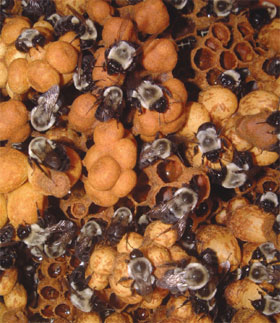 Where Do Bumble Bees Live?
Where Do Bumble Bees Live?
Bumble bees live in the ground in small extended families. For millions of years, an annual, life-sustaining drama has unfolded. As the spring sun warms the earth, a queen bumble bee emerges after months of hibernation in protective underground chambers.
She is alone in this chilly world; the rest of the family from the previous season has perished. The queen mated the previous fall and carries with her the nascent future colony as undeveloped eggs.
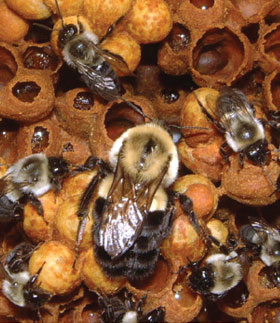 Nest Initiation and Brood Rearing
Nest Initiation and Brood Rearing
Once the nest site is established, the queen will gather soft nesting material, often fine grasses. With her body she fashions a cavity in the center of the nest.
She then extrudes thin strands of wax with which she will form a nectar cup. This structure will become a focal point in the nursery for developing bees.
During this hectic period, the queen is continually foraging for food while also tending her brood. The brood must be kept warm, especially during chilly spring nights.
The Next Generation
It takes approximately three weeks for a young bee to develop. Once an early generation of female bees has matured, they can assist their mother foraging for food and brooding the young—freeing the queen to focus on laying eggs.
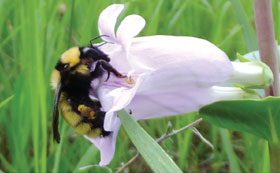 The queen must locate and provision a suitable nest with nectar and pollen from early-blooming plants. Pollen provides protein to complete the queen’s ovary development so that she can begin laying eggs.
The queen must locate and provision a suitable nest with nectar and pollen from early-blooming plants. Pollen provides protein to complete the queen’s ovary development so that she can begin laying eggs.
Nectar provides carbohydrates to provide the queen energy. As stewards, we must assure that the emerging bees find locally-appropriate, flowering native plants.
Nesting Sites and Forage Resources
Research suggests one very limiting factor for bumble bee success is a lack of suitable nesting sites. Suitable sites can often include existing sheltered places such as abandoned rodent holes, man-made structures, or grass clumps and brush piles.
Our bees need access to sunny, well drained patches of bare ground. Suitable sites can be developed by clearing vegetation from a small area. Exposing soil, by keeping a portion of a flower bed free of mulch is a quick and easy way to provide habitat for ground-nesting bees. Family building provides willing female workers to seek and gather food. Indirectly, it provides critical
pollination service to the flowering plant community that includes many food resources.
As with many aspects of nature – and indeed our own daily lives – plants and bees are mutually dependent. While the plants require pollinating bees for their fruits to reach maturity, the bee family requires continuous nourishment to carry out their work.
Planting for Bumble Bees
By thoughtfully cultivating a season-long progression of native flowering plants, we can nurture our bumble bees and enhance their life work.
SPRING
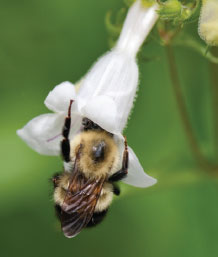
Smooth Beardtongue Penstemon digitalis
White flowers:
May – June
Partial sun – full sun
Soil: sandy-loam – clay-loam
Medium – dry
Height: 24″ – 36″
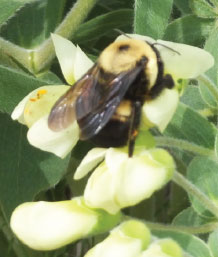
Cream Wild Indigo Baptisia bracteata
White – cream flowers:
May – June
Partial sun – full sun
Soil: sandy-loam – loam
Medium – dry
Height: 24″
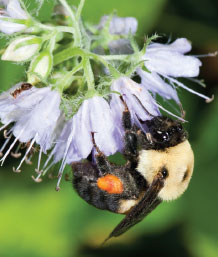
Virginia Waterleaf Hydrophyllum virginianum
Light pink – violet flowers:
April – May
Partial shade – partial sun
Soil: sandy-loam – clay-loam
Medium – dry
Height: 10″ – 15″
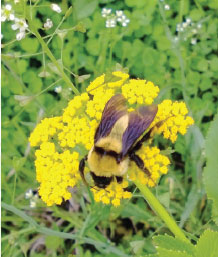
Golden Alexanders
Zizia aurea
Yellow flowers:
May – June
Partial sun – full sun
Soil: loam – clay-loam
Medium
Height: 24″ – 36″
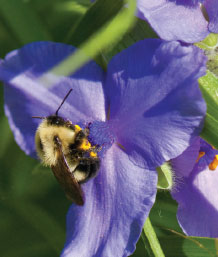
Ohio Spiderwort
Tradescantia ohiensis
Blue to violet flowers:
May – June
Partial sun – full sun
Soil: loam – clay-loam
Medium – dry
Height: 12″ – 18″
SUMMER
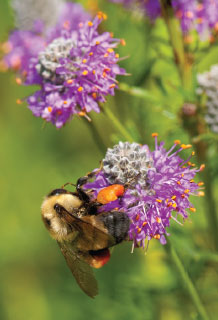
Purple Prairie Clover
Dalea purpurea
Pink – violet flowers:
July – August
Partial sun – full sun
Soil: sandy-loam – clay-loam
Medium – dry
Height: 10″ – 15″
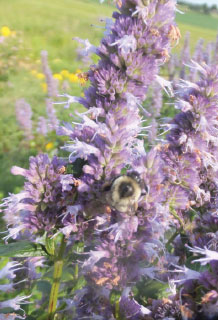
Anise Hyssop
Agastache foeniculum
Blue – violet flowers:
June – September
Partial sun – full sun
Soil: sand – loam
Medium – dry-medium
Height: 24″ – 36″
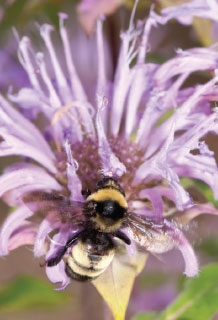
Wild Bergamot
Monarda fistulosa
Light – dark pink flowers:
July – September
Partial sun – full sun
Soil: sandy loam – clay-loam
Dry-medium – medium-moist
Height: 24″ – 36″
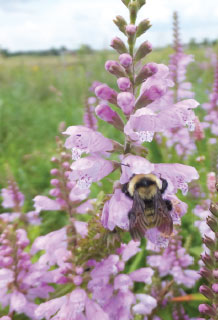
Obedient Plant
Physostegia virginiana
Pink – violet flowers:
August – September
Full sun
Soil: sandy-loam – clay-loam
Medium – moist
Height: 24″ – 36″
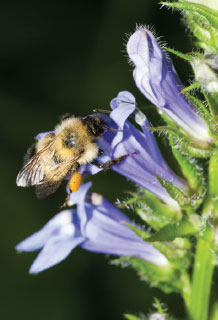
Blue Lobelia
Lobelia siphilitica
Blue – violet flowers:
July – September
Partial sun – full sun
Soil: sandy-loam – loam
Medium – moist
Height: 12″ – 18″
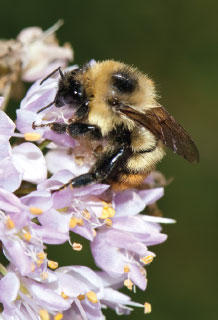
Prairie or Nodding Onion
Allium stellatum, A. cernuum
Light – dark pink flowers:
July – August
Full sun
Soil: sandy-loam – clay-loam
Dry-medium – medium-moist
Height: 6″ – 12″
AUTUMM
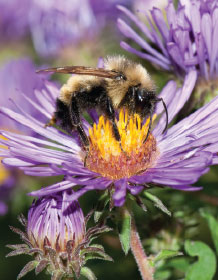
New England Aster
Aster novae-angliae
Pink to purple flowers:
September – October
Partial sun – full sun
Soil: sandy-loam – clay
Medium to moist
Height: 36″ – 48″
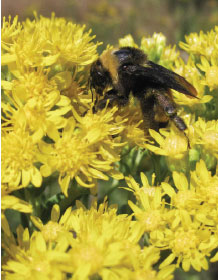
Stiff Goldenrod
Solidago rigida
Yellow flowers:
September
Full sun
Soil: sandy-loam – clay-loam
Medium to dry
Height: 24″ – 42″
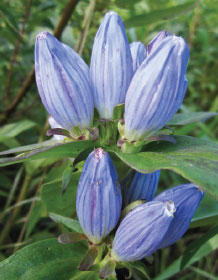
Bottle Gentian
Gentiana andrewsii
Blue to violet flowers:
September – October
Partial sun – full sun
Soil: loam – clay-loam
Medium to moist
Height: 12″ – 18″



